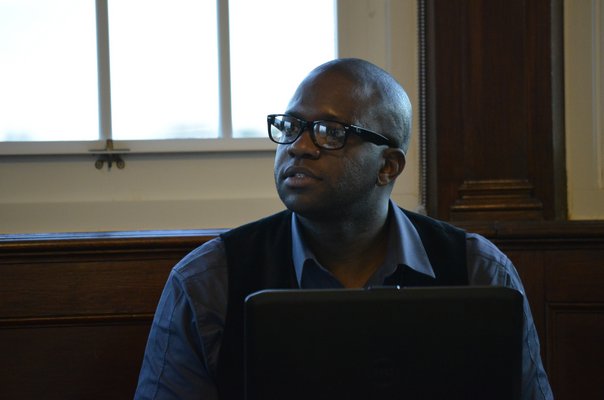
In the early 1700s it took much more planning and preparation to cook than it does today. During one of the few times a week that a family would cook with its beehive oven attached to a center fireplace, the foods that would take the longest time to bake would be slid into the fireplace first with a peel—a long iron tool made by a blacksmith that looks like a large spatula—and foods with a shorter cook time would be made last. The fireplace would start at up to 600 degrees Fahrenheit and the temperature would slowly drop as the day went on and the fire got smaller.The heat from the fire would radiate out of the oven, which typically measured about 3 feet deep, making it exceptionally warm inside the house on a cooking day, explained Larry Jones, who runs Westhampton Beach-based firm Jack L. Jones Building Conservation.
Enamored with the history behind center fireplaces, Mr. Jones proudly pointed out that his newest project—the installation of a center fireplace inside the yellow, 281-year-old Foster-Meeker House on Mill Road in Westhampton Beach—is expected to be finished in about six weeks.
Mr. Jones explained that families in the 1700s often built fireplaces in the middle of their houses because homeowners at the time would be taxed per fireplace. The center fireplace in the Foster-Meeker house measures 6 feet by 8 feet and provides heat to three rooms.
Believed to be the oldest building still standing in Westhampton Beach, the Foster-Meeker House was saved from demolition in 2008 when it was donated to the Westhampton Beach Historical Society by owner Water Goldstein. The historical society then moved the 1,100-square-foot Cape Cod-style building from its longtime location on Main Street to its new home on Mill Road, where the historical society is now based. The building sits directly next door to the organization’s headquarters, the Tuttle House.
The Foster-Meeker House is listed on both the national and state registers of historic places. The historical society oversaw the removal of all modern features from the structure following its relocation nearly a decade earlier and is finally advancing plans to completely restore it to its original condition.
The work on the fireplace was started in early February thanks to a $37,400 grant from the Robert Lion Gardiner Foundation, which matched money previously given to the historical society by several donors, explained the society’s director, Jon Stanat. The nearly $75,000 in total will be spent on interior renovations of the house, including the installation of the fireplace, hearths, a working replica chimney and a beehive oven, the latter of which features a dome-shape design that dates back to the Middle Ages; all items would have been used in the original structure, which was constructed in 1735, according to historians.
One of the most difficult aspects of building old fireplaces like the one in the Foster-Meeker house is finding enough bricks from the 1700s to use.
Peter and Kristian Moore, the father-and-son duo who were hired to do the restoration, ended up finding the thousands of bricks necessary to build the beehive oven near their hometown in Vermont. They salvaged approximately 5,000 bricks from a house built in the 1780s that was being torn down.
“You can’t just buy these,” the elder Mr. Moore said of the salvaged bricks, noting that new bricks are different in size, shape and look.
Mr. Moore, the owner of Peter Moore Masonry in Vermont, is always on the prowl for antique building materials, which aren’t easy to come by. “It’s like being an antique dealer,” he explained.
The 18th-century bricks also end up costing nearly three times as much as regular bricks—which typically go for about 80 cents apiece—because of the labor that goes into getting the bricks and then cleaning them, said Mr. Moore, who has been doing restorations for 42 years. His first historic restoration, he recalled, was a similar center fireplace in Manchester, Vermont.
“It’s a passion,” Mr. Moore said. “I really enjoy doing it—I find ways to make it look old. I look at every old fireplace that I possibly can, and that was how I learned how to do it … I felt part of the first guys who did it way back then.”
The Moores were recruited for the Foster-Meeker House work more than a year ago when the elder Mr. Moore met Mr. Jones, who was looking for parts to restore the Jeremiah Halsey Jr. house in Mecox, which was saved from demolition in 2014.
“It would have been a crime for that house to be dumped and torn down for no reason,” Mr. Jones said of the Halsey house.